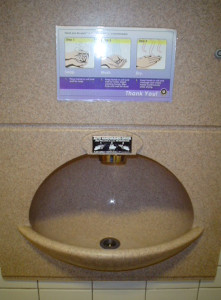Go evidence or go home.
Children are, according to The New Zealand Herald, becoming sick at one of the country’s most modern new schools, parents say, because for three years the board banned soap and hand towels, fearing that they harmed the environment.
The school, which has Greenstar accreditation for environmentally friendly design, has a healthy attendance rate of 93.4 per cent, the board says,  with no unusual illnesses.
with no unusual illnesses.
But some parents say their children are suffering due to the school founders’ green philosophy and have complained to the board about their children’s repeated bouts of illness.
Stonefields has stocked only hand sanitiser in bathrooms since it opened in February 2011.
After an approach from the Herald on Sunday this month, board chairman Israel Vaeliki said the school would install hand driers and soap dispensers.
One mum, who asked not to be named, said she, her husband and their child had suffered gastro-intestinal illnesses this year. “The hand sanitiser’s not effective.”
The woman had raised the issue with the school but had been assured handwashing, with soap, was available in the children’s learning hubs.
Another parent said her daughter and classmates had suffered several bouts of gastroenteritis, due to the lack of soap and hand driers. Instead, the children would wipe their wet and dirty hands on their clothes. But a third Stonefields parent, Camille Harvey, believed sanitiser was more effective as children tended to do a poor job with soap and water.
The original sanitiser solution was decided by the establishment board in consultation with the Ministry of Education before the school opened, Vaeliki said. “Having no paper towels was in line with the school’s environmental sustainability philosophy. Recently, the school has received one complaint about the solution but otherwise there have been no issues for three years.”
A ministry spokesman said schools were required to provide a cleaning agent and warm water so the potential spread of germs was kept to a minimum.
As hospitals in the U.S. began to realize several years ago, sanitizer does not replace proper handwashing with soap and drying with paper towel.
Water temperature does not matter, but a vigorous water flow does, as does the vigor of drying with paper. Hand driers don’t cut it.
A google search would have revealed handwashing basics for the environmental educationalists.













